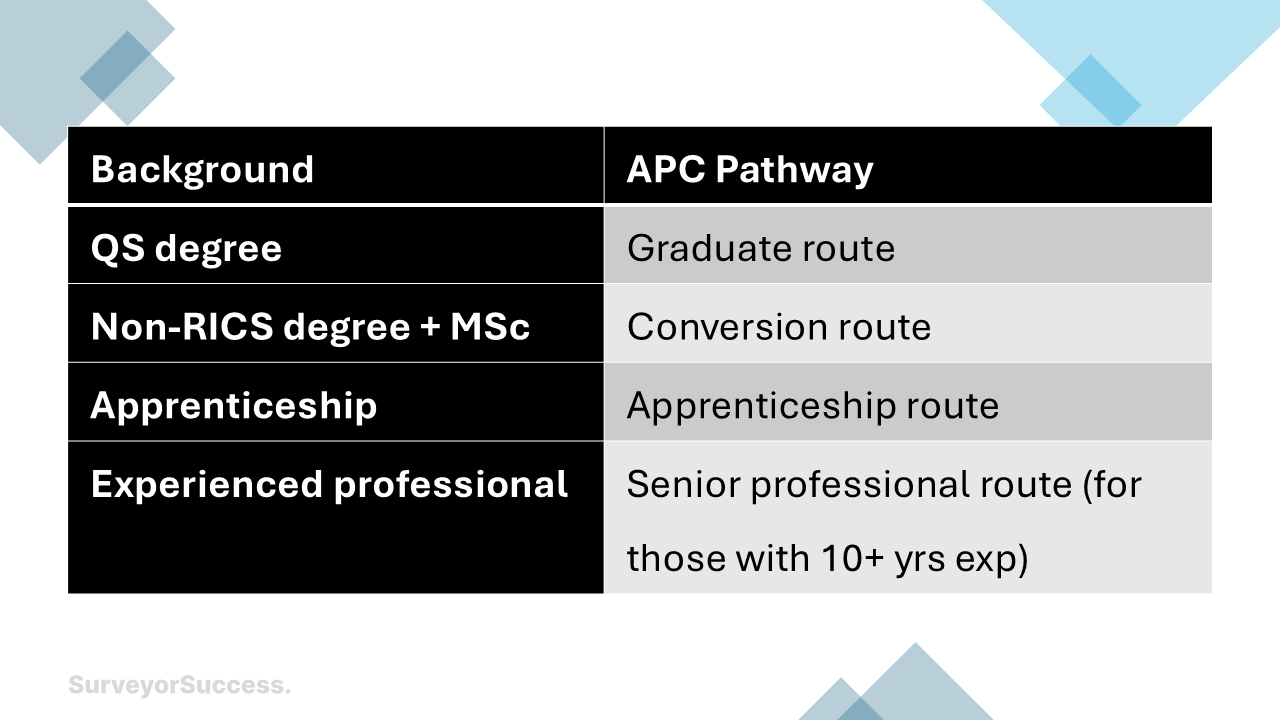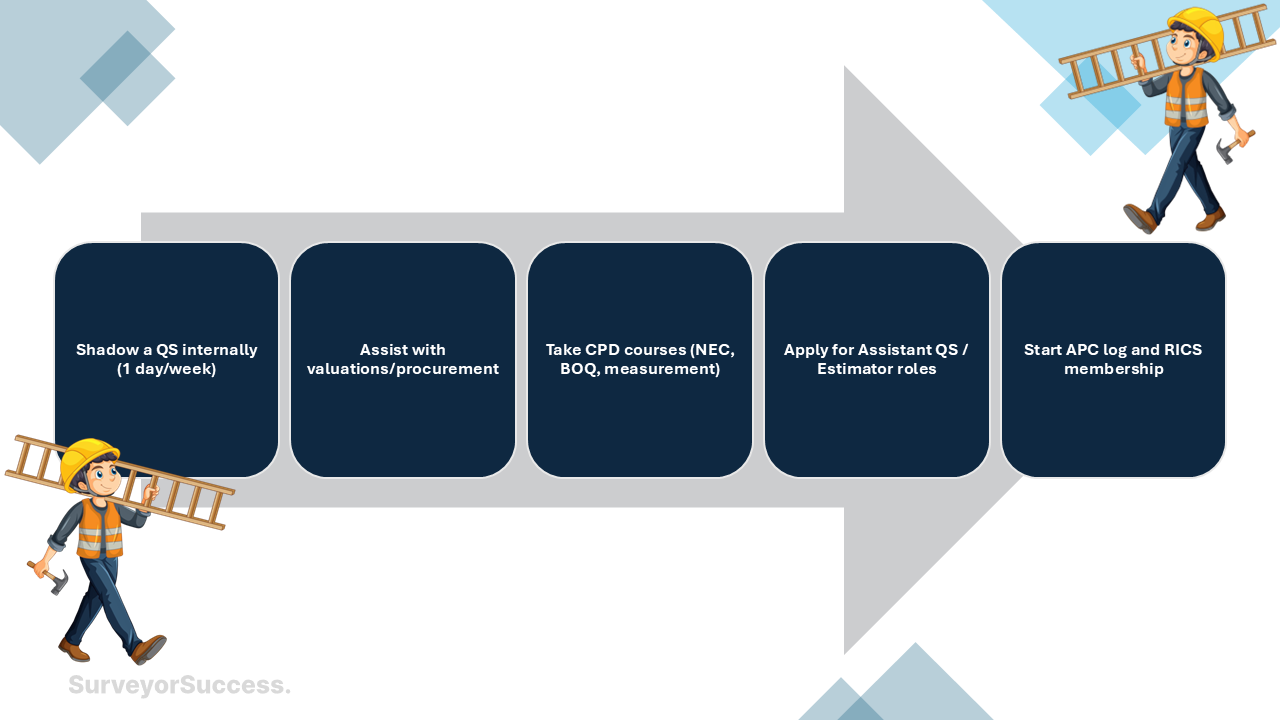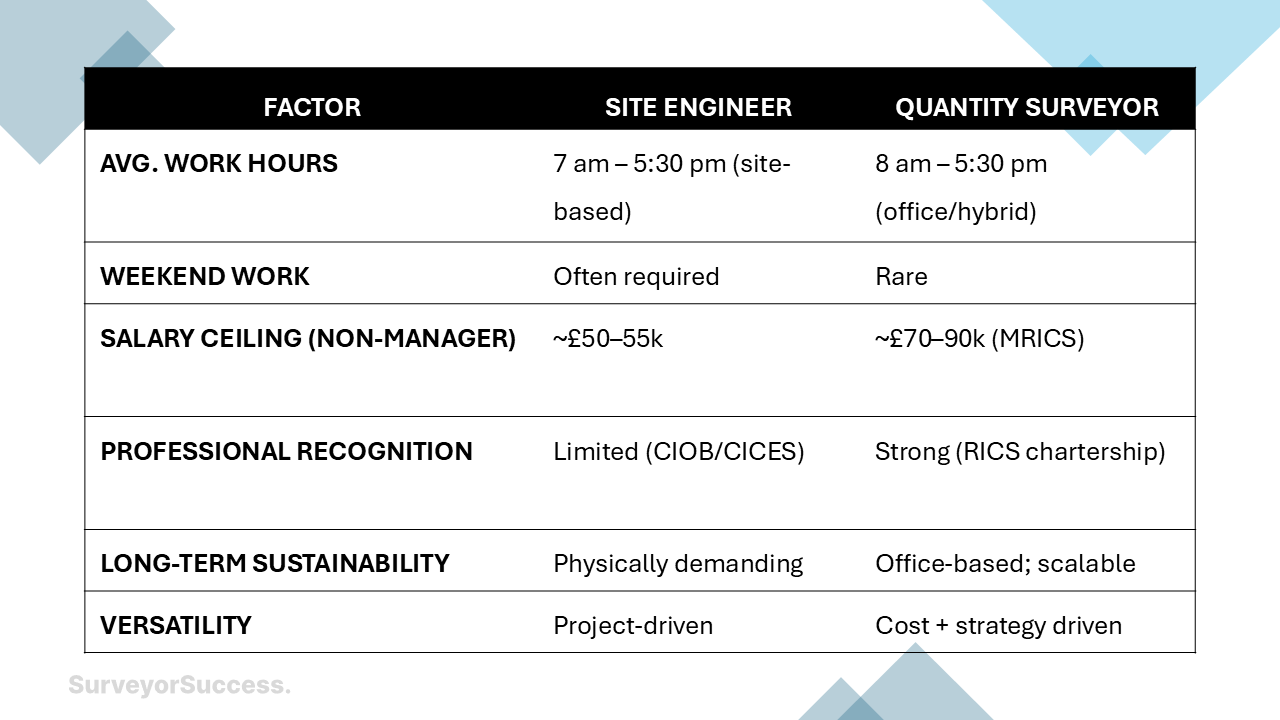July 8, 2025
32 min read
Get weekly updates with our Newsletter
Regular updates ensure that readers have access to fresh perspectives, making Poster a must-read.
Courage Oseghale
July 6, 2025
19 mins read

Ever felt your site-engineering experience has prepared you for more than overseeing formwork, QA checks, and snagging? You’re not alone. In the UK, many site engineers are realising that their deep understanding of drawings, schedules, and construction sequencing can translate seamlessly into a lucrative and structured career in quantity surveying.
In this article, we’ll explore how to become a quantity surveyor from a site engineer, showcasing why your site-based experience is an invaluable commercial asset. You’ll discover every route—whether it’s a RICS-accredited degree, postgrad conversion MSc, on-site apprenticeship, or entry into cost-control roles. We’ll also tackle practical steps: adapting your CV, closing knowledge gaps, and gaining RICS chartership via the APC. Plus, we’ll compare salaries, work-life balance, and career options—so you can evaluate if a transition is right for you.
Whether you're a seasoned site engineer exploring your next professional chapter or simply curious about QS rewards and progression, this guide gives you both strategic insights and actionable steps to change direction meaningfully.
Transitioning from site engineering to quantity surveying might feel like a leap, but in reality, it’s a logical and strategic step. The core knowledge and skills developed on-site—reading technical drawings, sequencing works, understanding materials and subcontractor coordination—form an excellent foundation for a successful QS career.
Site engineers are embedded in the day-to-day rhythm of a construction project. They’re responsible for:
These activities provide an intimate understanding of how construction projects are built, which is crucial for cost planning, valuations, and measuring works—key tasks for quantity surveyors.
Many employers value former site engineers in commercial roles because they bring practical awareness that purely academic QS graduates may lack, which involves knowing the product proficiently. Knowing how long certain tasks take—or when a subbie is cutting corners—makes you more precise in valuations and cost assessments.
Site engineers often manage setting-out schedules, temporary works, and progress tracking. These skills overlap heavily with quantity surveying tasks such as:
Let’s consider programming and sequencing: A site engineer knows how delays in drainage installation might push back substructure timelines. A QS uses this insight to evaluate claims for extensions of time or loss and expense. This commercial perspective, combined with your on-site lens, gives you an edge.
Many site engineers transitioning into QS roles report a quick learning curve because they’re already used to analysing project data, managing multiple stakeholders, and working to deadlines.
Take James, a civil site engineer with five years' experience on infrastructure projects in Manchester. Frustrated with long hours and stagnant pay, he enrolled in a part-time RICS-accredited MSc in Quantity Surveying at Salford University while continuing his role.
Midway through his course, he applied for a junior QS position at his company’s commercial team. With internal knowledge and strong site context, he quickly became indispensable for assessing subcontractor accounts and pricing variations. Within 18 months, he was promoted to Assistant Quantity Surveyor, on track for chartership.
Unique Insight:
The site to QS transition works best when you leverage internal moves within your company. You already know the people, processes, and culture, making it easier for commercial teams to support your transition.
While your site experience offers a powerful foundation, transitioning into a quantity surveying role often requires formal commercial education or RICS-aligned credentials, especially if your goal is to become chartered. Fortunately, there are several accessible routes to qualification in the UK, many of which are flexible enough to balance with work.
If you're earlier in your career or open to studying full-time, a RICS-accredited BSc in Quantity Surveying is the most direct route. These degrees typically take three years full-time or up to five years part-time and are offered by reputable UK institutions such as:
Modules include construction technology, procurement and tendering, contract administration, and measurement techniques.
📌 Tip: If you hold an HND or a BEng in civil engineering, some universities may offer direct entry into year 2 or year 3.
Do you already have an engineering degree? Consider a conversion master’s degree. These programmes are designed for non-QS graduates and typically last:
Popular MSc QS programmes in the UK include:
These courses often include RICS accreditation, enabling graduates to progress to chartered status via the APC pathway.
If returning to university isn’t ideal, UK apprenticeships offer an increasingly popular “earn while you learn” path. These include:
These government-supported programmes blend on-site work with structured learning, and are ideal for:
Employers often fund the course through the Apprenticeship Levy—a win-win for professionals and companies alike.
🔧 Example Path: Site Engineer → Enrol in Level 6 Chartered Surveyor Apprenticeship → Become Graduate QS → Apply for RICS APC
Whatever educational path you choose, most UK QS roles—especially senior ones—will eventually require RICS chartership. This is achieved through the Assessment of Professional Competence (APC), which involves:
Your route to the APC depends on your background:

Unique Insight:
Many transitioning site engineers succeed faster by combining part-time MSc study with real QS experience during the same period. This fast-tracks both education and the APC competency log.

For many site engineers looking to transition, the biggest challenge isn’t technical capability—it’s proving you can work in a commercially focused environment. While academic study helps with theory, actual cost-control experience is what employers (and RICS) are looking for. Here’s how to build that experience strategically.
One of the most accessible ways to gain QS exposure is through a secondment or lateral move within your current company. Many large UK contractors (like Kier, Balfour Beatty, or Morgan Sindall) encourage internal progression between departments.
Speak with your line manager or commercial lead about:
🔍 Pro Tip: Frame this move as career development aligned with company needs. Highlight your construction knowledge and explain your intention to support the commercial team while training toward chartered status.
If your company won’t offer internal transition, consider applying for entry-level commercial roles in the open market. These are great stepping stones:
These roles often welcome candidates with engineering or construction site backgrounds, especially those with an MSc or working toward one. Employers like Laing O’Rourke, Mace, and Galliford Try regularly post such hybrid roles.
💼 Job ad example: “Graduate or Junior Quantity Surveyor – Ideal for candidates with site experience seeking commercial progression.”
Once in the role, you’ll begin to log APC competencies under cost planning, procurement, and tendering, fast-tracking your RICS readiness.
Breaking into QS from engineering can also be accelerated through networking and continuous professional development (CPD). Consider:
🎓 RICS offers free online CPD courses for members, covering topics like “CostX software essentials” and “Introduction to procurement.”
Unique Insight:
Many QS hiring managers look favourably on candidates who invest in their commercial learning independently, even before landing a QS role. It shows initiative, commitment, and alignment with the profession’s ethics.
One of the most common reasons site engineers explore quantity surveying is the promise of greater financial reward, clearer progression paths, and a better work-life balance. But are these expectations realistic? Let’s break it down.
The UK construction salary market shows a clear financial incentive for site engineers transitioning into QS roles, especially once chartered.
.png)
While engineers in specialist infrastructure roles (like tunnelling or rail) may command premium rates, QS professionals benefit from:
Many engineers cite burnout as a reason for a career change. Early starts, long hours on exposed sites, weekend working, and temporary relocations are common across UK projects.
By contrast, quantity surveyors—while still working under pressure—often enjoy:
🔍 Quote from transitioning QS: “As an engineer, I was constantly chasing subcontractors in freezing weather. Now I manage packages from a cost perspective and feel much more in control of my schedule.” — James
Unique Insight:
The QS route is also less physically taxing, making it a sustainable long-term profession. This appeals to engineers in their late 30s or 40s, planning for career longevity.
Unlike engineering, where progression may stall unless you shift into project management, quantity surveying offers multiple upward routes:
Chartered status (MRICS) is a key unlock for these opportunities, often adding £10–£20k to base salaries and access to more complex, prestigious work.
🎓 MRICS = More than a title. It’s a career catalyst.

While transitioning from a site engineer to a quantity surveyor is highly achievable, it’s not without challenges. From technical gaps to professional certification hurdles, you’ll need to approach the move with intention and planning. Fortunately, there are proven ways to close these gaps effectively.
The most significant shift site engineers face when entering quantity surveying is the need for in-depth commercial knowledge, including:
Unlike engineering, where you’re focused on delivering the work, QS professionals must understand how contracts define risks, costs, liabilities, and timelines.
How to bridge this gap:
While engineers might use tools like AutoCAD, Revit, or MS Project, QSs rely more on:
🎓 Tip: UCEM and RICS both offer free or low-cost software tutorials for aspiring QS professionals.
If you're applying to QS roles, being familiar with Excel (Advanced usage) or similar tools gives you a clear advantage, even as a beginner.
Another overlooked challenge is the identity shift. Many site engineers identify with the delivery side of construction—being in hard hats, solving site problems, and leading crews. Moving into quantity surveying means:
Some engineers worry that they’ll be “desk-bound,” but in reality, many QSs still visit the site regularly to assess progress, variations, and valuations.
Engineers often excel technically but lack confidence when stepping into commercial conversations, especially when negotiating costs, dealing with subcontractor disputes or presenting a financial report to the directors and stakeholders.
Not to say it is easy to overcome this, however, some measures can be taken to overcome this:
Unique Insight:
Several engineers report that once they land their first commercial role, the steepest learning curve is in the first 6 months—but after that, it levels off, and the commercial mindset starts to come naturally.
To truly thrive as a QS, you’ll want to build structured professional development around:
Here’s a quick snapshot of support resources:
If you’re serious about becoming a quantity surveyor, this 6-step roadmap is designed to help you go from intention to implementation, regardless of whether you pursue academic study, professional training, or on-the-job transition.
Start by mapping out your current skills and how they align with QS competencies. As a site engineer, you likely already have:
✅ Technical understanding of drawings and sequencing
✅ Experience liaising with subcontractors and monitoring progress
✅ Familiarity with site logistics and programme impacts
Now identify gaps such as:
❌ Cost planning and BOQ preparation
❌ NEC/JCT contract knowledge
❌ Measurement and valuation skills
Use this audit to decide if you need a formal qualification or if experience and CPD will be enough.
Refer back to Section 3 to choose the best route:
Start your application early and look into scholarships or employer support, especially if you’re studying part-time.
You can’t become a QS on theory alone. Work with your current employer to:
If an internal move isn’t possible, apply externally for:
Once you’re in a commercial role, join RICS as a Student or Associate Member. This gives you access to:
📘 Tip: Even if you’re early in your journey, keeping a log of your commercial experience from day one makes the APC process smoother and faster later on.
Start filling your knowledge gaps through focused CPD:
🎓 Contracts – Learn NEC3/NEC4, JCT, FIDIC basics
📊 Measurement – Practice BOQ take-offs and CostX tutorials
📚 Procurement – Understand tender evaluation, bid comparison
🧠 Legal – Study variations, loss & expense, EOTs
Platforms like RICS, CIOB, and UCEM offer bite-sized learning.
Pro tip: Join a study group or peer network—WhatsApp or LinkedIn groups focused on APC can make learning less isolating.
When you’re ready to make the switch officially:
Transitioning from a site engineer to a quantity surveyor isn’t just a career pivot—it’s a strategic evolution. With your strong technical foundation, hands-on project understanding, and problem-solving mindset, you’re already halfway there.
The move to quantity surveying offers greater financial rewards, improved work-life balance, and a clearer progression path. It also opens doors to chartership, international opportunities, and leadership roles in commercial and cost management.
Whether you choose to study part-time, apply for an entry-level commercial role, or pursue the RICS APC directly, the key is to start where you are and take intentional steps forward.
You don’t need to know everything at once. But with the right training, mentoring, and commitment, you can transform your site experience into a highly valued commercial asset—not just for your next role, but for the rest of your career.
🎯 Now is the time to act. Explore your qualification options, speak with your commercial team, and begin logging your CPD today. The profession is waiting, and the demand for your hybrid skills has never been higher.
Yes. Many UK professionals take the part-time MSc in Quantity Surveying route or enter through a Level 6 Chartered Surveyor apprenticeship, allowing them to gain experience while studying. You can also qualify through the RICS Senior Professional Route if you have significant experience.
While not legally required, RICS chartership (MRICS) is highly respected and often essential for senior QS, commercial manager, or consultancy roles. It’s a clear signal of competence and professionalism, especially valuable if you’re transitioning from a non-commercial background.
If you're transitioning with relevant experience and pursuing an MSc or apprenticeship, you can expect £35,000–£45,000 in London and £30,000–£40,000 in the regions, depending on the sector. Employers value your practical insight, especially in infrastructure or civils.
Depending on your route, it can take 2 to 5 years to gain qualifications and achieve RICS chartered status. A part-time MSc + 2 years of structured experience is a common and achievable path for many UK site engineers.
The most common challenges include understanding contract law, cost valuation methods, and using QS software like CostX or Bluebeam. These can be overcome with targeted CPD training, mentorship, and on-the-job exposure through shadowing or junior QS roles.
Regular updates ensure that readers have access to fresh perspectives, making Poster a must-read.
©SurveyorSuccess. All rights reserved.


